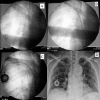Performance of venous port catheter insertion by a general surgeon: a prospective study
- PMID: 26011202
- PMCID: PMC4452970
- DOI: 10.9738/INTSURG-D-14-00214.1
Performance of venous port catheter insertion by a general surgeon: a prospective study
Abstract
As part of the vascular access procedures, venous ports, commonly referred to as catheters, are placed under the skin to enable safe and easy vascular access for administration of repeated drug treatments. 122 patients who had received a venous port catheter insertion procedure in the general surgery department between January 1012 and January 2014 were involved in this study. Patients were divided into two groups: those who had undergone a fluoroscopy (group 1) and those who had not undergone a fluoroscopy (group 2). Complications that emerged during and after the port catheter insertion procedure and successful insertion rates were recorded in the database. Data of these patients were presented in a prospective manner. There were 92 to 30 patients in groups 1 and 2, respectively. In group 1, the mean age was approximately 56.8, total catheter stay time was 20,631 days, and mean time of port use was 224.2 days. In group 2, the mean age was approximately 61.2, total catheter stay time was 13,575 days, and mean time of port use was 452.5 days. Successful insertion rate was 100% and 90% in groups 1 and 2, respectively (P < 0.05). The proper insertion of the port catheter accompanied by monitoring methods can decrease procedure-related complications. Statistical comparisons between the two groups in terms of malposition and successful insertion rates also support this view (P < 0.05). The findings support the view that in cancer patients, a venous port catheter insertion accompanied by a fluoroscopy can be safely performed by general surgeons.
Keywords: Cancer; Infusion treatment; Port catheter.
Figures
References
-
- Carlo JT, Lamont JP, McCarty TM, Livingston S, Kuhn JA. A prospective randomized trial demonstrating valved implantable ports have fewer complications and lower overall cost than nonvalved implantable ports. Am J Surg. 2004;188(6):722–727. - PubMed
-
- Krupski G, Froschle GW, Weh FJ, Schlosser GA. Central venous access devices in treatment of patients with malignant tumors: venous port, central venous catheter and Hickman catheter. Cost-benefit analysis based on a critical review of the literature, personal experiences with 135 port implantations and patient attitude. Chirurg. 1995;66(3):202–207. - PubMed
-
- Morris SL, Jacques PF, Mauro MA. Radiology-assisted placement of implantable subcutaneous infusion ports for long-term venous access. Radiology. 1992;184(1):149–151. - PubMed
-
- Biffi R, Corrado F, de Braud F, de Lucia F, Scarpa D, Testori A, et al. Long-term, totally implantable central venous access ports connected to a Groshong catheter for chemotherapy of solid tumours: experience from 178 cases using a single type of device. Eur J Cancer. 1997;33(8):1190–1194. - PubMed
-
- Mansfield PF, Hohn DC, Fornage BD, Gregurich MA, Ota DM. Complication and failure of subclavian vein catheterization. N Engl J Med. 1994;331(26):1735–1738. - PubMed
MeSH terms
LinkOut - more resources
Full Text Sources
Other Literature Sources
Research Materials



